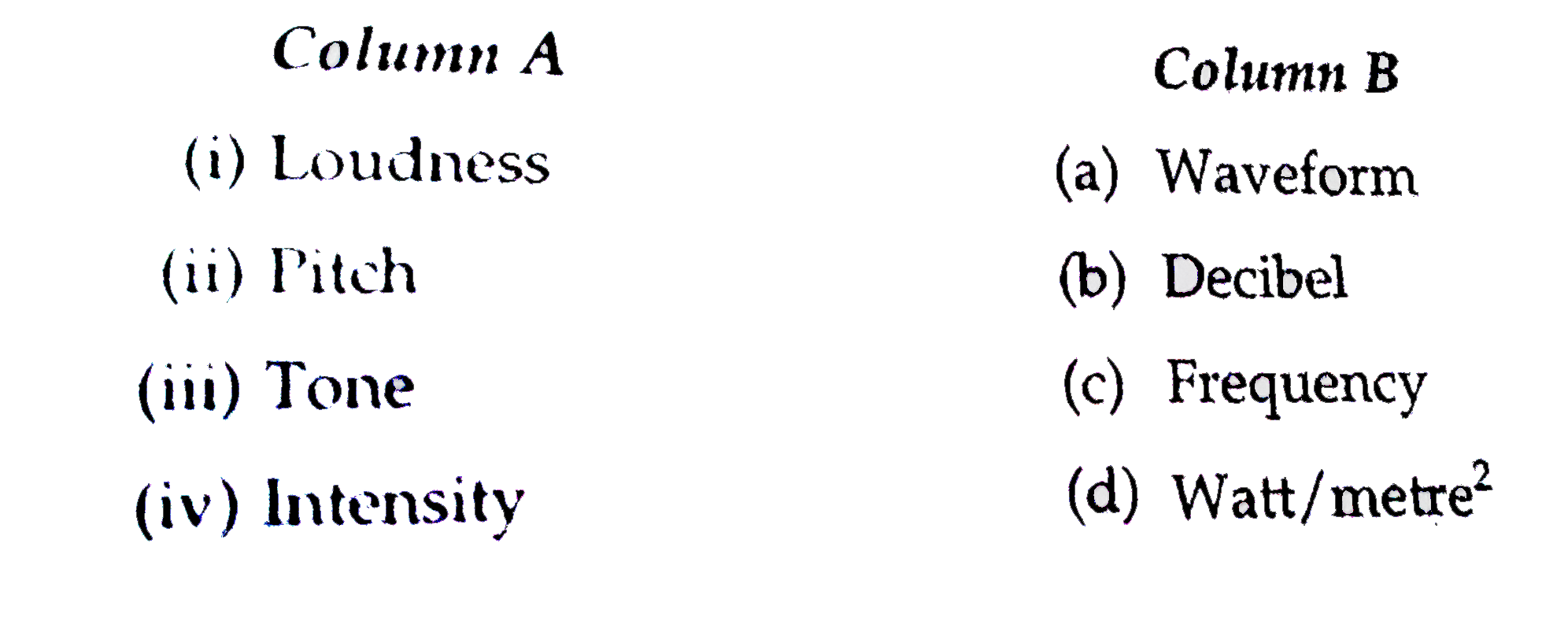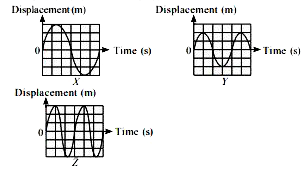When we hear a sound, we understand it mainly on the basis of three parameters, called intensity, pitch and tone. These quatities, in turn, depend on cetain measurable quantities associated with the sound.
Which of the following statements regarding the pitch of a sound is not correct?
The pitch of a sound depends only on tis frequency.
The difference between the frequencies of two sounds is called their ' interval'.
If two sounds differ by N octaves, the ratio of their frequencies is 2N
Different notes on a musical scale differ only in pitch.
The correct Answer is:B
Step by step video, text & image solution for When we hear a sound, we understand it mainly on the basis of three parameters, called intensity, pitch and tone. These quatities, in turn, depend on cetain measurable quantities associated with the sound. Which of the following statements regarding the pitch of a sound is not correct? by Physics experts to help you in doubts & scoring excellent marks in Class 12 exams.
Updated on:21/07/2023Topper's Solved these Questions
- PRACTICE WORKSHEET 3BOOK - D MUKHERJEECHAPTER - PRACTICE WORKSHEET 3EXERCISE - Matrix-Matching Type
1 Videos
- PRACTICE WORKSHEET 3BOOK - D MUKHERJEECHAPTER - PRACTICE WORKSHEET 3EXERCISE - Assertion- Reason Type
3 Videos
- PRACTICE WORKSHEET 2BOOK - D MUKHERJEECHAPTER - PRACTICE WORKSHEET 2EXERCISE - Linked- Comprehension Type
4 Videos
- PROPERTIES OF MATTER,FLUIDSBOOK - D MUKHERJEECHAPTER - PROPERTIES OF MATTER,FLUIDSEXERCISE - Type 2
35 Videos
Similar Questions
We identify and understand a sound on the basis of certain characteristics, given in column A. These characteristics depend on certain measurable parameters of the sound. These parameters and related units are given in column B.

View SolutionMention three conditions on which the pitch of sound depends.
View Solution
Knowledge Check
When we hear a sound, we understand it mainly on the basis of three parameters, called intensity, pitch and tone. These quatities, in turn, depend on cetain measurable quantities associated with the sound.
Which of the following statements regarding the tone of a sound in not correct?AThe tone of a sound depends on its waveform.BWe indentify the source of a sound by its tone.CThe tone of a sound improves if most of its harmonics are present along with the fundamental.DThe second harmonic of a sound can also be called its second overtone.When we hear a sound, we understand it mainly on the basis of three parameters, called intensity, pitch and tone. These quatities, in turn, depend on cetain measurable quantities associated with the sound.
Which of the following statements regarding the intensity and loudness of a sound is not correct?AThe unit of intensity is W/m2BThe unit of loudness is the decibel.CThe loudness of a sound is directly proportional to its intensityDThe intensity depends on the frequency, amplitude, density of the medium and the velocity of sound in the medium.Which one among the following statements regarding heart sound is correct?
AHeart sounds are caused by the internal blood flow inside the heart.BHeart sounds are caused by the external blood flow outside the heart.CHeart sounds are caused by opening and closing or hert valves.Dnormal sounds are called 'murmurs'.
Read the passage given below and answer the questions that follow.
Screaming is exhibited by many animals, but no species uses this extreme vocalization in as many different contexts as humans. Though we're pretty good at recognizing a scream when we hear one, the wide variety of screams makes it difficult to pin down what defines them.
To study screams is to probe the fuzzy boundary that separates humans from the rest of the animal kingdom. It is a way to explore our pre-linguistic past. Although we are fully symbolic creatures today, on occasion a trace of our primal selves bubbles to the surface in the form of a scream. Understanding its characteristics could improve the treatment of nonverbal patients, help fight crime, or simply make movies more frightening. But first scientists need to explain what makes a scream a scream.
To that end, researchers at Emory University’s Bioacoustics Laboratory recruited 181 volunteers to listen to short recordings of 75 nonverbal human vocalizations, such as screams, laughter, and crying. For each of the 75 sounds, the volunteers were asked to indicate whether they thought it was a scream. The researchers then analyzed 28 acoustic signatures of the sounds, such as pitch, frequency, and timbre, to determine which parameters influence the perception of a sound as a scream.
Most people would say that the defining characteristic of a scream is that it is a focused loud and highpitched, but previous scream research suggests otherwise. In 2015, David Poeppel, a neuroscientist at New York University and the Max Planck Institute, led a study to determine the acoustic qualities that differentiate fearful screams from other nonverbal vocalizations. To do this, Poeppel and his colleagues compiled a corpus of screams lifted from YouTube videos and ones recorded in their lab, then asked volunteers to rank them according to how alarming the sound was. Poeppel also imaged the brains of his volunteers as they listened to screams to see how these sounds affected neural activity.
Which of the following statement is false according to the given passage.
View SolutionThe diagram shows three waves X, Y and Z displayed on the screen of the oscilloscope connected to a microphone when three different sounds are made in front of the microphone.

Which of the following statements is correct regarding different sounds?
View SolutionRajiv took three substances P, Q, and R and burnt them one by one. He noted down his observations given below. (I) Substance P burns quickly producing heat and light. (II) Substance Q burns in room temperature on its own. (III) Substance R burns with the evolution of heat, light, and sound. Which of the following statements regarding the given information is correct?
View SolutionThe velocity of sound in dry air is Vd, and in moist air it is Vm. The velocities are measured under the same conditions of temperature and pressure. Which of the following statements is fully correct?
View SolutionTwo loudspeaker M and N are located 20m apart and emit sound at frequencies 118Hz and 121Hz, respectively. A car is intially at a point P, 1800m away from the midpoint Q of the line MNandmoves→wardsQconstantlyat60 km//hralongtheperpedica––rbisec→rofMN.itcrossesQandeventuallyreachesap∮R,1800mawayomQ.≤tv(t)representthebeatequencymeasuredbyapersonsi∈g∈thecarattimet.≤tv_(P),v_(Q) and v_(R)bethebeatequenciesmeasuredatlocationsP,QandR, respectively. the speed of sound in air is 330ms−1. which of the following statement (s) is (are) true regarding the sound heard by the person?
View Solution
